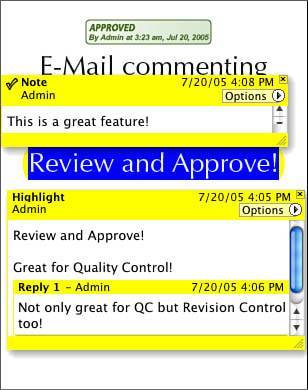Job Management or Tracking Workflow
Review and Approval WorkflowsAs with all workflows, you must inventory your current solution(s). If a change needs to be made, define your requirements for your review and approval workflow. Then, look for solutions that fit those requirements. What are the common components of review and approval, and what are some of the common solutions found on the market today? Best practices for review and approval of content typically require two proofing cyclesone by staff and another by the content creator. Often a final approval is done by someone such as a manager responsible for quality or brand control. This person checks for usage (is the logo sized per standards), correctness of content (did they use the correct image based on version and copy), production requirements, elements style, and typographic errors. Too many reviewers and approvers can cause a complete breakdown in the system and make it difficult for the content generator to get her job done in a timely manner. But you would be surprised by the number of workflows I've seen crippled by too many contributors with no restraint or respect for the proofing cycle, calling in corrections as late as press time. Can you imagine what such a routine costs the company? How are these proofing cycles accomplished? One option is accomplished via hard-copy proofs, perhaps first in black and white and maybe only for correct assets, placement, and text-related checks or by using PDF as a soft proof option. Then perhaps the next round of proofing centers on color, for content and tagging. Final approval and production checks might be reserved for management. An internal device might be used to accomplish this. These proofs can be distributed internally by hand-carrying them or externally via a carrier service. Once releasedand only if this job is headed for a printing pressyour service provider might send you proofs, previously agreed to, in the form of page proofs, contract proofs, remote hard proofs, remote soft proofs, or onsite press checks. PDFs can be employed in the review and approval cycle because they are easily created and distributed. If members of the cycle own Acrobat, they can mark up or annotate the PDF with their comments. Those comments can be informally collected, and the original layout can be modified accordingly. With the advent of Acrobat 7 Professional, the content creator can sponsor email review and approval without the recipients owning Acrobat. The creator simply generates a PDF and, using the new feature in version 7 called "Allow Reader Commenting," turns the PDF into an "intelligent document" and the PDF gives the recipient commenting tools. The only software the recipient needs is Adobe Reader 7, which is a free download from Adobe. The creator, from within Acrobat, submits the PDF for an email review. Then, after the comments are placed by the recipient, he clicks Send Comments and the creator receives the reviewer's notes. See Figure D.10 for an example. Figure D.10. PDF comments. If an email approach to review and approval entails too much traffic, you could sponsor web approval, also available in Acrobat with a WebDAV-enabled server. You could also get a third-party web solution such as Rosebud PLM (http://www.rosebudplm.com). This method invites the reviewers to a specific URL, where they will preview the PDF and add their comments that in turn will be sent back to the creator. To move beyond these features, you can step up to collaboration applications or online services that create common workspaces for invitees to join in, collaborate, and annotate. These begin to fall into the category of project management. Microsoft SharePoint technologies is a platform designed specifically for collaborative applications. These types of solutions should be considered when collaboration or approval, either wholly or in part, takes place outside your domain or network.
|
EAN: 2147483647
Pages: 148
